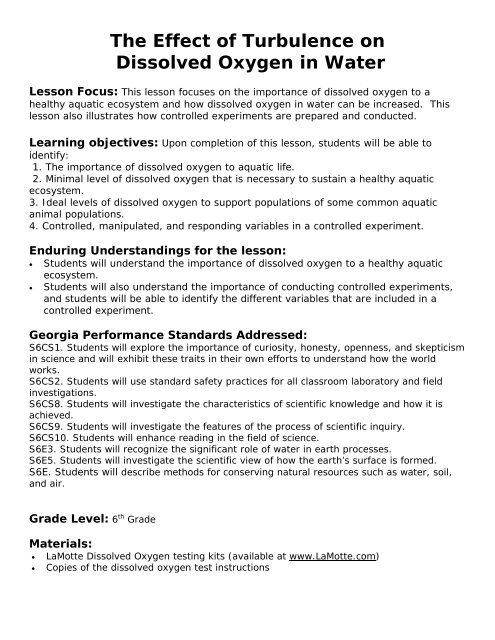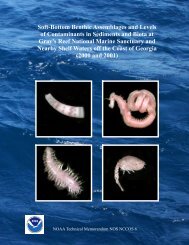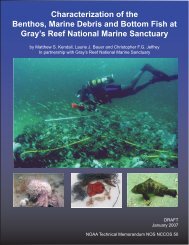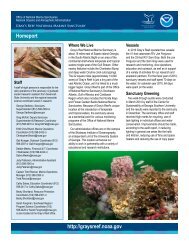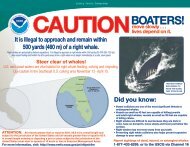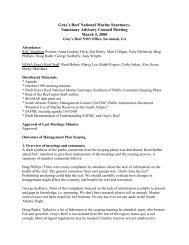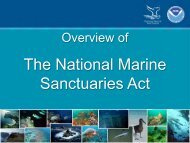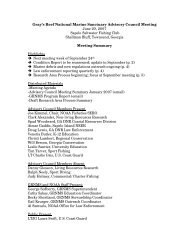The Effect of Turbulence on Dissolved Oxygen in Water - Grade 6
The Effect of Turbulence on Dissolved Oxygen in Water - Grade 6
The Effect of Turbulence on Dissolved Oxygen in Water - Grade 6
Create successful ePaper yourself
Turn your PDF publications into a flip-book with our unique Google optimized e-Paper software.
<str<strong>on</strong>g>The</str<strong>on</strong>g> <str<strong>on</strong>g>Effect</str<strong>on</strong>g> <str<strong>on</strong>g>of</str<strong>on</strong>g> <str<strong>on</strong>g>Turbulence</str<strong>on</strong>g> <strong>on</strong><strong>Dissolved</strong> <strong>Oxygen</strong> <strong>in</strong> <strong>Water</strong>Less<strong>on</strong> Focus: This less<strong>on</strong> focuses <strong>on</strong> the importance <str<strong>on</strong>g>of</str<strong>on</strong>g> dissolved oxygen to ahealthy aquatic ecosystem and how dissolved oxygen <strong>in</strong> water can be <strong>in</strong>creased. Thisless<strong>on</strong> also illustrates how c<strong>on</strong>trolled experiments are prepared and c<strong>on</strong>ducted.Learn<strong>in</strong>g objectives: Up<strong>on</strong> completi<strong>on</strong> <str<strong>on</strong>g>of</str<strong>on</strong>g> this less<strong>on</strong>, students will be able toidentify:1. <str<strong>on</strong>g>The</str<strong>on</strong>g> importance <str<strong>on</strong>g>of</str<strong>on</strong>g> dissolved oxygen to aquatic life.2. M<strong>in</strong>imal level <str<strong>on</strong>g>of</str<strong>on</strong>g> dissolved oxygen that is necessary to susta<strong>in</strong> a healthy aquaticecosystem.3. Ideal levels <str<strong>on</strong>g>of</str<strong>on</strong>g> dissolved oxygen to support populati<strong>on</strong>s <str<strong>on</strong>g>of</str<strong>on</strong>g> some comm<strong>on</strong> aquaticanimal populati<strong>on</strong>s.4. C<strong>on</strong>trolled, manipulated, and resp<strong>on</strong>d<strong>in</strong>g variables <strong>in</strong> a c<strong>on</strong>trolled experiment.Endur<strong>in</strong>g Understand<strong>in</strong>gs for the less<strong>on</strong>:• Students will understand the importance <str<strong>on</strong>g>of</str<strong>on</strong>g> dissolved oxygen to a healthy aquaticecosystem.• Students will also understand the importance <str<strong>on</strong>g>of</str<strong>on</strong>g> c<strong>on</strong>duct<strong>in</strong>g c<strong>on</strong>trolled experiments,and students will be able to identify the different variables that are <strong>in</strong>cluded <strong>in</strong> ac<strong>on</strong>trolled experiment.Georgia Performance Standards Addressed:S6CS1. Students will explore the importance <str<strong>on</strong>g>of</str<strong>on</strong>g> curiosity, h<strong>on</strong>esty, openness, and skepticism<strong>in</strong> science and will exhibit these traits <strong>in</strong> their own efforts to understand how the worldworks.S6CS2. Students will use standard safety practices for all classroom laboratory and field<strong>in</strong>vestigati<strong>on</strong>s.S6CS8. Students will <strong>in</strong>vestigate the characteristics <str<strong>on</strong>g>of</str<strong>on</strong>g> scientific knowledge and how it isachieved.S6CS9. Students will <strong>in</strong>vestigate the features <str<strong>on</strong>g>of</str<strong>on</strong>g> the process <str<strong>on</strong>g>of</str<strong>on</strong>g> scientific <strong>in</strong>quiry.S6CS10. Students will enhance read<strong>in</strong>g <strong>in</strong> the field <str<strong>on</strong>g>of</str<strong>on</strong>g> science.S6E3. Students will recognize the significant role <str<strong>on</strong>g>of</str<strong>on</strong>g> water <strong>in</strong> earth processes.S6E5. Students will <strong>in</strong>vestigate the scientific view <str<strong>on</strong>g>of</str<strong>on</strong>g> how the earth’s surface is formed.S6E. Students will describe methods for c<strong>on</strong>serv<strong>in</strong>g natural resources such as water, soil,and air.<strong>Grade</strong> Level: 6 th <strong>Grade</strong>Materials:• LaMotte <strong>Dissolved</strong> <strong>Oxygen</strong> test<strong>in</strong>g kits (available at www.LaMotte.com)• Copies <str<strong>on</strong>g>of</str<strong>on</strong>g> the dissolved oxygen test <strong>in</strong>structi<strong>on</strong>s
gr_effect_<str<strong>on</strong>g>of</str<strong>on</strong>g>_turbulence_<strong>on</strong>_dissolved_oxygen_<strong>in</strong>_water rev, 11/1/10• Four-10 gall<strong>on</strong> aquariums, aquarium filter pump, fan, thermometer, and an aquariumaerator.• Copies <str<strong>on</strong>g>of</str<strong>on</strong>g> the <strong>Dissolved</strong> <strong>Oxygen</strong>/C<strong>on</strong>trolled Experiments worksheet• Copies <str<strong>on</strong>g>of</str<strong>on</strong>g> <strong>in</strong>formati<strong>on</strong>al handouts for each student.• LCD projector available to use with a classroom computer that has <strong>in</strong>ternet access.Time needed: Two full 40 m<strong>in</strong>ute class periods are needed to adequately cover theobjectives <str<strong>on</strong>g>of</str<strong>on</strong>g> this less<strong>on</strong>. More could be required based <strong>on</strong> the extensi<strong>on</strong>s or details that theteacher chooses to <strong>in</strong>cludeBackground Informati<strong>on</strong>:<strong>Dissolved</strong> <strong>Oxygen</strong>- <strong>Dissolved</strong> oxygen is oxygen gas that is dissolved <strong>in</strong> water. <str<strong>on</strong>g>The</str<strong>on</strong>g> amount<str<strong>on</strong>g>of</str<strong>on</strong>g> dissolved oxygen (DO) found <strong>in</strong> water can vary due to several factors such as watertemperature, level <str<strong>on</strong>g>of</str<strong>on</strong>g> pollutants and whether the flow is slow or rapid just to name a few.Fish and other aquatic organisms need dissolved oxygen to survive. <str<strong>on</strong>g>The</str<strong>on</strong>g> amount <str<strong>on</strong>g>of</str<strong>on</strong>g>dissolved oxygen needed for survival <str<strong>on</strong>g>of</str<strong>on</strong>g> <strong>in</strong>dividuals and for susta<strong>in</strong><strong>in</strong>g healthy populati<strong>on</strong>s <str<strong>on</strong>g>of</str<strong>on</strong>g>aquatic organisms varies by species. Fish tend to need more dissolved oxygen than otherspecies <str<strong>on</strong>g>of</str<strong>on</strong>g> animals. Aquatic plants and algae even require dissolved oxygen to survive.Dur<strong>in</strong>g the night or even <strong>on</strong> cloudy days, plants and algae perform respirati<strong>on</strong>, whichrequires oxygen, when they are not produc<strong>in</strong>g oxygen as a product <str<strong>on</strong>g>of</str<strong>on</strong>g> photosynthesis. <str<strong>on</strong>g>The</str<strong>on</strong>g>level <str<strong>on</strong>g>of</str<strong>on</strong>g> dissolved oxygen <strong>in</strong> a stream, river, or body <str<strong>on</strong>g>of</str<strong>on</strong>g> water tends to change throughouteach day and each seas<strong>on</strong>.<strong>Dissolved</strong> oxygen is measured as milligrams <str<strong>on</strong>g>of</str<strong>on</strong>g> dissolved gaseous oxygen per liter <str<strong>on</strong>g>of</str<strong>on</strong>g>water (mg/L), or parts per milli<strong>on</strong> (ppm). <strong>Dissolved</strong> oxygen <strong>in</strong> water can range from 0to 14 parts per milli<strong>on</strong>. Generally, the colder the water temperature the higher thedissolved oxygen, which creates a great habitat for animals. Streams and rivers requiredissolved oxygen (DO) levels at a m<strong>in</strong>imum <str<strong>on</strong>g>of</str<strong>on</strong>g> 5-6 parts per milli<strong>on</strong> (ppm) to support ahealthy and diverse aquatic ecosystem. However fish and macro<strong>in</strong>vertebrates areknown to survive at dissolved oxygen levels as low as 3.0 ppm <strong>in</strong> warm watertemperatures due to their adaptati<strong>on</strong>s for survival under these c<strong>on</strong>diti<strong>on</strong>s.<str<strong>on</strong>g>The</str<strong>on</strong>g>re are a variety <str<strong>on</strong>g>of</str<strong>on</strong>g> factors that can <strong>in</strong>crease the level <str<strong>on</strong>g>of</str<strong>on</strong>g> dissolved oxygen <strong>in</strong> water.<strong>Dissolved</strong> oxygen naturally enters the water from the atmosphere and will c<strong>on</strong>t<strong>in</strong>ue toenter the water until it becomes saturated. When aquatic plants and algae are exposedto sunlight they produce oxygen as a waste product <str<strong>on</strong>g>of</str<strong>on</strong>g> photosynthesis. <str<strong>on</strong>g>The</str<strong>on</strong>g> structure <str<strong>on</strong>g>of</str<strong>on</strong>g>a stream or river affects dissolved oxygen. <str<strong>on</strong>g>The</str<strong>on</strong>g> more turbulence that a stream or riverdisplays, such as waterfalls or rapids, the more oxygen is absorbed <strong>in</strong>to the water. Also,turbulence <strong>on</strong> the surface <str<strong>on</strong>g>of</str<strong>on</strong>g> a body <str<strong>on</strong>g>of</str<strong>on</strong>g> water caused by w<strong>in</strong>d tends to <strong>in</strong>crease levels <str<strong>on</strong>g>of</str<strong>on</strong>g>dissolved oxygen. Artificial aerati<strong>on</strong> such as with an aquarium bubble st<strong>on</strong>e will <strong>in</strong>creaseDO levels, sometimes dramatically.However, there are some processes that reduce dissolved oxygen levels <strong>in</strong> water. Allliv<strong>in</strong>g organisms must respire to survive. Animals such as fish, crustaceans, mollusks,and worms that live <strong>in</strong> water remove oxygen from the water for respirati<strong>on</strong>. Plants andPage 2 <str<strong>on</strong>g>of</str<strong>on</strong>g> 8
gr_effect_<str<strong>on</strong>g>of</str<strong>on</strong>g>_turbulence_<strong>on</strong>_dissolved_oxygen_<strong>in</strong>_water rev, 11/1/10algae also need oxygen to respire at night or <strong>on</strong> cloudy days. As the amount <str<strong>on</strong>g>of</str<strong>on</strong>g> deadorganic material <strong>in</strong>creases <strong>in</strong> water more oxygen is used by bacteria to decompose thatmaterial. <str<strong>on</strong>g>The</str<strong>on</strong>g>se organic wastes can come from agricultural run<str<strong>on</strong>g>of</str<strong>on</strong>g>f, <strong>in</strong>dustrial wastes, orsewage treatment plants. Chemical polluti<strong>on</strong> can also reduce DO levels due to chemicalreacti<strong>on</strong>s with dissolved oxygen. Nitrates, amm<strong>on</strong>ia, sulfates, and other i<strong>on</strong>s reducelevels <str<strong>on</strong>g>of</str<strong>on</strong>g> dissolved oxygen when they enter bodies <str<strong>on</strong>g>of</str<strong>on</strong>g> water.Two weather factors, temperature and barometric pressure, can also affect levels <str<strong>on</strong>g>of</str<strong>on</strong>g>dissolved oxygen. As temperature <strong>in</strong>creases, water tends to hold less dissolved oxygenso dissolved oxygen levels <strong>in</strong> water tend to decrease when it is warmer. And when it iscooler dissolved oxygen levels tend to <strong>in</strong>crease. Also, as barometric pressure <strong>in</strong>creases,the solubility <str<strong>on</strong>g>of</str<strong>on</strong>g> oxygen <strong>in</strong>creases so levels <str<strong>on</strong>g>of</str<strong>on</strong>g> dissolved oxygen tend to <strong>in</strong>crease.Some aquatic organisms are more sensitive to low levels <str<strong>on</strong>g>of</str<strong>on</strong>g> dissolved oxygen thanothers. Trout, striped bass, perch, and shad are fish that require 5 to 6 ppm <str<strong>on</strong>g>of</str<strong>on</strong>g> dissolvedoxygen to survive. While trout are spawn<strong>in</strong>g, dissolved oxygen should not be below 7.0ppm. If dissolved oxygen falls below 4.0 ppm some fish and <strong>in</strong>vertebrate populati<strong>on</strong>ssuch as <strong>in</strong>sects and crustaceans will beg<strong>in</strong> to decl<strong>in</strong>e. When DO levels are between 3.0and 4.0 ppm, fish will start com<strong>in</strong>g to the surface and beg<strong>in</strong> pip<strong>in</strong>g. Pip<strong>in</strong>g is when fishcome to the surface and gulp, or gasp, for air. Some crustaceans such as crabs andcrayfish can survive <strong>in</strong> waters with dissolved oxygen as low as 3.0 ppm. Organismscomm<strong>on</strong>ly associated with poor water quality such as leeches, sludge worms and othertypes <str<strong>on</strong>g>of</str<strong>on</strong>g> worms can live <strong>in</strong> water with low dissolved oxygen levels.C<strong>on</strong>trolled experiments- Be<strong>in</strong>g able to perform c<strong>on</strong>trolled experiments and identifythe proper parts <str<strong>on</strong>g>of</str<strong>on</strong>g> a c<strong>on</strong>trolled experiment are a necessary skill for any scientist. In ac<strong>on</strong>trolled experiment, certa<strong>in</strong> c<strong>on</strong>diti<strong>on</strong>s and requirements must be met to determ<strong>in</strong>e avalid c<strong>on</strong>clusi<strong>on</strong>. If an experiment is not performed properly it will create <strong>in</strong>accurate orfalse results and data.In a c<strong>on</strong>trolled experiment, there are always factors (also called variables) that are<strong>in</strong>volved. Only <strong>on</strong>e variable should be changed at a time by the scientist dur<strong>in</strong>g anexperiment. <str<strong>on</strong>g>The</str<strong>on</strong>g> <strong>on</strong>e factor that the scientist changes <strong>in</strong> an experiment is called themanipulated variable. All other variables that could affect the experiment should rema<strong>in</strong>c<strong>on</strong>stant and are called c<strong>on</strong>trolled variables. Any variable that changes as a result <str<strong>on</strong>g>of</str<strong>on</strong>g>chang<strong>in</strong>g the manipulated variable is called the resp<strong>on</strong>d<strong>in</strong>g variable.For example, if a scientist is try<strong>in</strong>g to see if add<strong>in</strong>g fertilizer to plants would help themgrow more quickly he or she would need to identify the variables at work <strong>in</strong> thisexperiment. <str<strong>on</strong>g>The</str<strong>on</strong>g>re are a few variables that should rema<strong>in</strong> c<strong>on</strong>stant so that a validc<strong>on</strong>trolled experiment could be c<strong>on</strong>ducted. First, there should be some plants that getfertilizer and some that do not. <str<strong>on</strong>g>The</str<strong>on</strong>g> plants that d<strong>on</strong>’t get fertilizer are our c<strong>on</strong>trolsubjects. We measure the effect <str<strong>on</strong>g>of</str<strong>on</strong>g> the manipulated variable <strong>on</strong> other subjects aga<strong>in</strong>stthese c<strong>on</strong>trol subjects. To make sure that <strong>on</strong>ly the amount <str<strong>on</strong>g>of</str<strong>on</strong>g> fertilizer is a factoraffect<strong>in</strong>g plant growth, the scientist should make sure that all <str<strong>on</strong>g>of</str<strong>on</strong>g> the plants are the samePage 3 <str<strong>on</strong>g>of</str<strong>on</strong>g> 8
gr_effect_<str<strong>on</strong>g>of</str<strong>on</strong>g>_turbulence_<strong>on</strong>_dissolved_oxygen_<strong>in</strong>_water rev, 11/1/10type <str<strong>on</strong>g>of</str<strong>on</strong>g> plant (roses, tomatoes, etc.), be the same height and age and <str<strong>on</strong>g>of</str<strong>on</strong>g> similar health,and receive the same amount <str<strong>on</strong>g>of</str<strong>on</strong>g> water and sunlight each day. Other less obviousfactors should also rema<strong>in</strong> c<strong>on</strong>stant, such as ambient temperature and <strong>in</strong>tensity or angle<str<strong>on</strong>g>of</str<strong>on</strong>g> sunlight. <str<strong>on</strong>g>The</str<strong>on</strong>g> factors that rema<strong>in</strong> c<strong>on</strong>stant would be called c<strong>on</strong>trolled variables. <str<strong>on</strong>g>The</str<strong>on</strong>g><strong>on</strong>e factor the scientist changes should be the amount <str<strong>on</strong>g>of</str<strong>on</strong>g> fertilizer that the plants get;this would be c<strong>on</strong>sidered the manipulated variable. <str<strong>on</strong>g>The</str<strong>on</strong>g> change <strong>in</strong> the plants’ heightswould be the variable that changes as a result <str<strong>on</strong>g>of</str<strong>on</strong>g> chang<strong>in</strong>g the amount <str<strong>on</strong>g>of</str<strong>on</strong>g> fertilizer thateach plant gets. This would be called the resp<strong>on</strong>d<strong>in</strong>g variable.Before actually design<strong>in</strong>g and c<strong>on</strong>duct<strong>in</strong>g the experiment, a scientist should state theproblem that he or she is try<strong>in</strong>g to solve. This could be written as a scientific questi<strong>on</strong>as well. In the example <str<strong>on</strong>g>of</str<strong>on</strong>g> the fertilizer, the scientist could ask, “How does add<strong>in</strong>gfertilizer affect the growth <str<strong>on</strong>g>of</str<strong>on</strong>g> plants?” A hypothesis should also be written. A hypothesisis an “if…, then…” statement that is a possible explanati<strong>on</strong> for a set <str<strong>on</strong>g>of</str<strong>on</strong>g> observati<strong>on</strong>s.Us<strong>in</strong>g the fertilizer example, a hypothesis could be, “If plants are given fertilizer, thenthey will grow faster.”Learn<strong>in</strong>g Procedure1. Beg<strong>in</strong> the less<strong>on</strong> by ask<strong>in</strong>g students what they know about water quality. Ask if thereis any way that they can measure water to judge its quality ( maybe through how itlooks, smells, tastes, (be careful with <strong>in</strong>clud<strong>in</strong>g taste – it is usually recommendedpeople d<strong>on</strong>’t taste as it can be harmful) and feels)2. Give each student a copy <str<strong>on</strong>g>of</str<strong>on</strong>g> the dissolved oxygen/c<strong>on</strong>trolled experiments worksheetand have them answer the first questi<strong>on</strong> about water quality.3. Give each student a copy <str<strong>on</strong>g>of</str<strong>on</strong>g> the 2 handouts - “Informati<strong>on</strong> <strong>on</strong> <strong>Dissolved</strong> <strong>Oxygen</strong>” and“Informati<strong>on</strong> <strong>on</strong> C<strong>on</strong>trolled Experiments”. Have the students read these handoutsand then answer questi<strong>on</strong>s 2-7 <strong>on</strong> their own.4. Us<strong>in</strong>g your classroom computer and a LCD projector, visitwww.edl<strong>on</strong>l<strong>in</strong>e.org/learncenter/oxygenmodule.asp. This site shows how fish behaviorchanges as dissolved oxygen levels change <strong>in</strong> the water. While visit<strong>in</strong>g this site askstudents how they expect fish to behave under different c<strong>on</strong>diti<strong>on</strong>s. Have them writetheir ideas <strong>on</strong> the worksheet5. Inform the students they are now go<strong>in</strong>g to c<strong>on</strong>duct an experiment. Discuss howc<strong>on</strong>trolled experiments are performed, plac<strong>in</strong>g importance <strong>on</strong> identify<strong>in</strong>g the 3 types<str<strong>on</strong>g>of</str<strong>on</strong>g> variables <strong>in</strong> an experiment: the manipulated variable, c<strong>on</strong>trolled variables and theresp<strong>on</strong>d<strong>in</strong>g variable.6. Review safety rules as this test requires the use <str<strong>on</strong>g>of</str<strong>on</strong>g> some very dangerous chemicals.7. Have students copy the follow<strong>in</strong>g data log <strong>in</strong>to their notebooksPage 4 <str<strong>on</strong>g>of</str<strong>on</strong>g> 8
gr_effect_<str<strong>on</strong>g>of</str<strong>on</strong>g>_turbulence_<strong>on</strong>_dissolved_oxygen_<strong>in</strong>_water rev, 11/1/10Sample name <str<strong>on</strong>g>Turbulence</str<strong>on</strong>g> type Temperature DO (ppm)C<strong>on</strong>troln<strong>on</strong>eFilter w/o “smallcartridge waterfall”Fanw<strong>in</strong>dAquarium aerator aerator8. Divide students <strong>in</strong>to groups <str<strong>on</strong>g>of</str<strong>on</strong>g> 3 or 4.9. Have students beg<strong>in</strong> the experiment by review<strong>in</strong>g the procedure for dissolved oxygentest<strong>in</strong>g. <str<strong>on</strong>g>The</str<strong>on</strong>g>y will be c<strong>on</strong>duct<strong>in</strong>g a W<strong>in</strong>kler Titrati<strong>on</strong> us<strong>in</strong>g a LaMotte <strong>Dissolved</strong> <strong>Oxygen</strong>test<strong>in</strong>g kit10. Dem<strong>on</strong>strate the first test to the class us<strong>in</strong>g water from a 10 gall<strong>on</strong> aquarium thathas been sitt<strong>in</strong>g for 24 hours or more – this is your c<strong>on</strong>trol.11. Have students repeat the chemical test for the other 3 variables.• To simulate a small waterfall use a standard aquarium filter to create the fall<strong>in</strong>gwater similar to a small waterfall. Remove the cartridge from the filter toprevent any error that the filter could create, this also allows the water to flowfaster and more freely.• To simulate the affect <str<strong>on</strong>g>of</str<strong>on</strong>g> w<strong>in</strong>d, place a fan near the surface <str<strong>on</strong>g>of</str<strong>on</strong>g> the water and letit blow <strong>on</strong> the water <strong>in</strong> the aquarium.• To simulate aerati<strong>on</strong>, use an aquarium aerator <strong>in</strong>stead <str<strong>on</strong>g>of</str<strong>on</strong>g> the fan for 24 hoursor so.11. Log your results <strong>in</strong> a data table. Ask the students which method added the mostoxygen to the water. Were they surprised?Evaluati<strong>on</strong>Inspect the student’s worksheet for proper identificati<strong>on</strong> <str<strong>on</strong>g>of</str<strong>on</strong>g> factors that affect dissolvedoxygen <strong>in</strong> water and for identificati<strong>on</strong> <str<strong>on</strong>g>of</str<strong>on</strong>g> the variables <strong>in</strong>volved <strong>in</strong> this experiment.Evaluate students’ participati<strong>on</strong> <strong>in</strong> the experiment. Did each student do their fair share<str<strong>on</strong>g>of</str<strong>on</strong>g> the work? Were their data results with<strong>in</strong> 10% <str<strong>on</strong>g>of</str<strong>on</strong>g> the <strong>in</strong>structor’s?Extensi<strong>on</strong>s1. Have students th<strong>in</strong>k <str<strong>on</strong>g>of</str<strong>on</strong>g> other variables they could test that would impact the levels<str<strong>on</strong>g>of</str<strong>on</strong>g> DO <strong>on</strong> a water sample such as temperature or pH. Tests could even be createdto determ<strong>in</strong>e the affect <str<strong>on</strong>g>of</str<strong>on</strong>g> ambient temperature or atmospheric pressure <strong>on</strong> thelevel <str<strong>on</strong>g>of</str<strong>on</strong>g> dissolved oxygen <strong>in</strong> a water sample.2. Have students look for different bodies <str<strong>on</strong>g>of</str<strong>on</strong>g> water around their school or <strong>in</strong> theircommunities and make predicti<strong>on</strong>s as to what the levels <str<strong>on</strong>g>of</str<strong>on</strong>g> DO would be for each.3. Have students predict what plant and animal life the various bodies <str<strong>on</strong>g>of</str<strong>on</strong>g> water couldsupport and what adaptati<strong>on</strong>s they may have to help them survive.Resources-• Wheel<strong>in</strong>g Jesuit University, Classroom <str<strong>on</strong>g>of</str<strong>on</strong>g> the Future, <strong>Water</strong> Quality module,www.cotf.edu 10/21/07Page 5 <str<strong>on</strong>g>of</str<strong>on</strong>g> 8
gr_effect_<str<strong>on</strong>g>of</str<strong>on</strong>g>_turbulence_<strong>on</strong>_dissolved_oxygen_<strong>in</strong>_water rev, 11/1/10• Stevens Institute <str<strong>on</strong>g>of</str<strong>on</strong>g> Technology, Center for Innovati<strong>on</strong> <strong>in</strong> Eng<strong>in</strong>eer<strong>in</strong>g and ScienceEducati<strong>on</strong>, <strong>Dissolved</strong> <strong>Oxygen</strong> background page, www.k12science.org 10/21/07• Envir<strong>on</strong>mental Distance Learn<strong>in</strong>g, “Even fish need water” learn<strong>in</strong>g module,www.edl<strong>on</strong>l<strong>in</strong>e.org 10/21/07• Envir<strong>on</strong>mental Protecti<strong>on</strong> Agency, M<strong>on</strong>itor<strong>in</strong>g and Assess<strong>in</strong>g <strong>Water</strong> Quality, VolunteerStream M<strong>on</strong>itor<strong>in</strong>g Methods Manual , Chapter 5 secti<strong>on</strong> 2 <strong>Dissolved</strong> <strong>Oxygen</strong> andBiochemical <strong>Oxygen</strong> Demand, www.epa.gov (10/21/07)• Chesapeake Bay Program, <strong>Dissolved</strong> <strong>Oxygen</strong> Criteria Page,http://www.Chesapeakebay.net 10/21/07• University <str<strong>on</strong>g>of</str<strong>on</strong>g> Wisc<strong>on</strong>s<strong>in</strong>, Green Bay, Lower Fox River <strong>Water</strong>shed M<strong>on</strong>itor<strong>in</strong>g Program ,Data M<strong>on</strong>itor<strong>in</strong>g, <strong>Dissolved</strong> <strong>Oxygen</strong> Page, www.uwgb.edu• University <str<strong>on</strong>g>of</str<strong>on</strong>g> Florida, Institute <str<strong>on</strong>g>of</str<strong>on</strong>g> Food and Agricultural Sciences Extensi<strong>on</strong>, Fact SheetFA27 “<strong>Dissolved</strong> <strong>Oxygen</strong> for Fish Producti<strong>on</strong>” by Ruth Francis-Floydhttp://edis.ifas.ufl.edu/FA002 10/21/07• Central New York Near-Real Time Surface <strong>Water</strong> Quality Network, DataInterpretati<strong>on</strong>, <strong>Dissolved</strong> <strong>Oxygen</strong> Page, www.ourlake.org 10/21/07• Kentucky <strong>Water</strong> Watch Volunteer Projects, <strong>Water</strong> Quality M<strong>on</strong>itor<strong>in</strong>g Project, ChemicalTest<strong>in</strong>g, <strong>Dissolved</strong> <strong>Oxygen</strong> Page www.state.ky.us 10/21/07Less<strong>on</strong> developed by: Rusty Sturken, Duluth Middle SchoolThis activity is a product <str<strong>on</strong>g>of</str<strong>on</strong>g> the Rivers to Reef Teacher Workshop sp<strong>on</strong>sored by theGeorgia Aquarium and NOAA Gray’s Reef Nati<strong>on</strong>al Mar<strong>in</strong>e Sanctuary, <strong>in</strong> which theauthors participated. For more <strong>in</strong>formati<strong>on</strong> about this workshop, Georgia Aquarium, orGray’s Reef Nati<strong>on</strong>al Mar<strong>in</strong>e Sanctuary, please visit our websites atwww.georgiaaquarium.org or http://graysreef.noaa.gov/Page 6 <str<strong>on</strong>g>of</str<strong>on</strong>g> 8
gr_effect_<str<strong>on</strong>g>of</str<strong>on</strong>g>_turbulence_<strong>on</strong>_dissolved_oxygen_<strong>in</strong>_water rev, 11/1/10Worksheet: <strong>Dissolved</strong> <strong>Oxygen</strong>/C<strong>on</strong>trolled ExperimentsName-_______________________________________ Date-________ Period-______Pre-read<strong>in</strong>g- Complete this secti<strong>on</strong> before read<strong>in</strong>g the handouts <strong>on</strong> dissolved oxygenand c<strong>on</strong>trolled experiments.1. How would you describe water <strong>in</strong> a river or any body <str<strong>on</strong>g>of</str<strong>on</strong>g> water that is good quality?How does it look, smell, taste (see cauti<strong>on</strong>ary note above) and feel? Is there anyth<strong>in</strong>g<strong>in</strong> the water that can be measured to see how good it is?__________________________________________________________________________________________________________________________________________________________________________________________________________________Post-read<strong>in</strong>g- Complete this secti<strong>on</strong> after read<strong>in</strong>g the handouts <strong>on</strong> dissolved oxygenand c<strong>on</strong>trolled experiments.2. What is dissolved oxygen?____________________________________________________________________________________________________________________________________________3. Why is dissolved oxygen important to water quality?____________________________________________________________________________________________________________________________________________4. In what unit is dissolved oxygen measured? ________________________________5. How much dissolved oxygen is needed for water quality to be c<strong>on</strong>sidered very well?______________________________________________________________________6. What are 3 factors that <strong>in</strong>crease levels <str<strong>on</strong>g>of</str<strong>on</strong>g> dissolved oxygen <strong>in</strong> water?____________________________________________________________________________________________________________________________________________7. What are 2 factors that lower levels <str<strong>on</strong>g>of</str<strong>on</strong>g> dissolved oxygen <strong>in</strong> water?____________________________________________________________________________________________________________________________________________Page 7 <str<strong>on</strong>g>of</str<strong>on</strong>g> 8
gr_effect_<str<strong>on</strong>g>of</str<strong>on</strong>g>_turbulence_<strong>on</strong>_dissolved_oxygen_<strong>in</strong>_water rev, 11/1/108. What k<strong>in</strong>ds <str<strong>on</strong>g>of</str<strong>on</strong>g> organisms can live <strong>in</strong> water with less than 5.0 ppm <str<strong>on</strong>g>of</str<strong>on</strong>g> dissolvedoxygen?____________________________________________________________________________________________________________________________________________Web video- visit www.edl<strong>on</strong>l<strong>in</strong>e.org/learncenter/oxygenmodule.asp and read the<strong>in</strong>structi<strong>on</strong>s about mov<strong>in</strong>g the fish.9. Before your teacher moves the fish, predict what will happen when the fish is movedto other tank with a different amount <str<strong>on</strong>g>of</str<strong>on</strong>g> dissolvedoxygen.______________________________________________________________________________________________________________________________________10. Expla<strong>in</strong> what really happened when the fish was moved to different amounts <str<strong>on</strong>g>of</str<strong>on</strong>g>dissolved oxygen. _______________________________________________________________________________________________________________________Post-experiment- Answer these questi<strong>on</strong>s after the class performs the dissolvedoxygen experiment <strong>on</strong> the sec<strong>on</strong>d day.9. Write a hypothesis about dissolved oxygen <strong>in</strong> our experiment.____________________________________________________________________________________________________________________________________________10. Name 2 c<strong>on</strong>trolled variables <strong>in</strong> our experiment.____________________________________________________________________________________________________________________________________________11. Name the manipulated variable used <strong>in</strong> our experiment.______________________________________________________________________12. Name the resp<strong>on</strong>d<strong>in</strong>g variable <strong>in</strong> our experiment.____________________________13. Was your hypothesis correct? _______Why or why not? .__________________________________________________________________________________________________________________________Page 8 <str<strong>on</strong>g>of</str<strong>on</strong>g> 8


